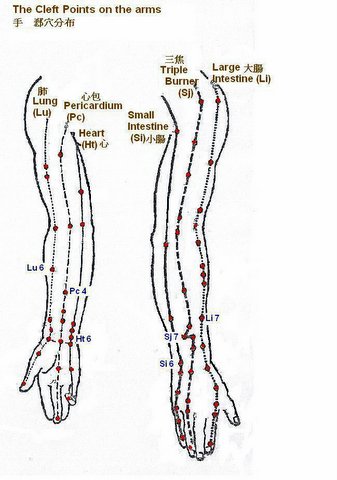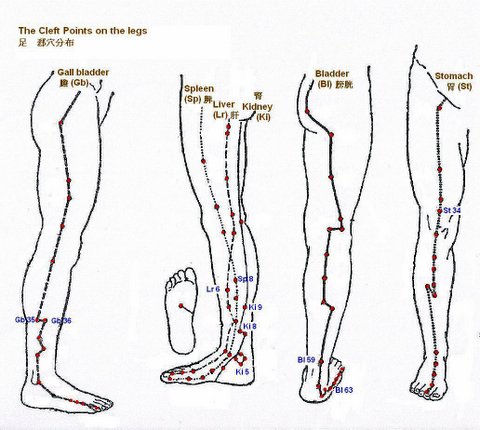Cleft Points
In the meridian system, cleft points are specific points where the qi and blood of the twelve regular meridians, the Yin and Yang Link Vessels, Yin and Yang Heel Vessels deeply converge. These points are mostly located below the elbows and knees.
The cleft points are places where qi and blood are deeply stored. Generally, they cannot be attacked easily by the pathogens. In cases if there are reactions in these points, it means pathogens have deeply entered the body and conditions can develop rapidly and seriously. The cleft points are often selected when acute severe pain and inflammation occurred along the meridians or in the corresponding organs.
The cleft points in the yin meridians are commonly used for acute conditions, pain, inflammation, and chronic diseases related to the meridian and its associated organs. while those in the yang meridians are more common for pain relief. For example, kong zui (Lu 6) is used for coughing up blood due to lung diseases, zhong du (Lr 6) for metrorrhagia (abnormal uterine bleeding), yang lao (Si 6) is selected for acute lower back pain, and liang qiu (St 34) is chosen for acute stomach pain.
The cleft points can be used alone, but they are often be combined with the eight influential points in acute conditions. For example, in treating acute gastritis, physicians will select liang qiu (St 34) along with zhong wan (Cv 12, influential point of the qi).
Table of the 16 Cleft Points on the Yin and Yang Meridians
| Yin Meridians | Cleft points |
Yang Meridians | |
| Lung Meridian |
kong zui (Lu 6) | wen liu (Li 7) | Large Intestine Meridian |
| Pericardium Meridian |
xi men (Pc 4) | hui zong (Sj 7) | Triple Burner Meridian |
| Heart Meridian |
yin xi (Ht 6) | yang lao (Si 6) | Small Intestine Meridian |
| Spleen Meridian |
di ji (Sp 8) | liang qiu (St 34) | Stomach Meridian |
| Liver Meridian |
zhong du (Lr 6) | wai qiu (Gb 36) | Gallbladder Meridian |
| Kidney Meridian |
shui quan (Ki 5) | jin men (Bl 63) | Bladder Meridian |
| Yin Link Vessel |
zhu bin (Ki 9) | yang jiao (Gb 35) | Yang Link Vessel |
| Yin Heel Vessel |
jiao xin (Ki 8) | fu yang (Bl 59) | Yang Heel Vessel |

Cleft points on the arms

Cleft points on the legs


